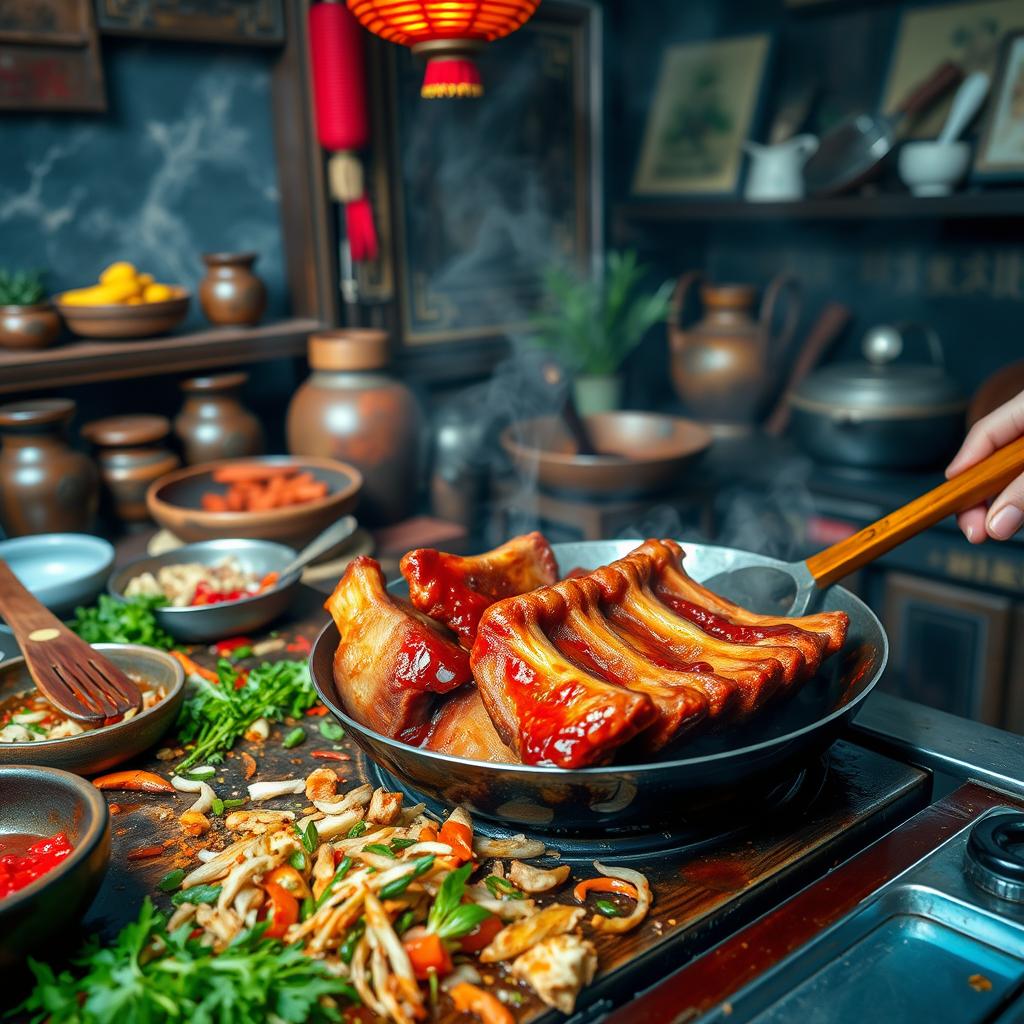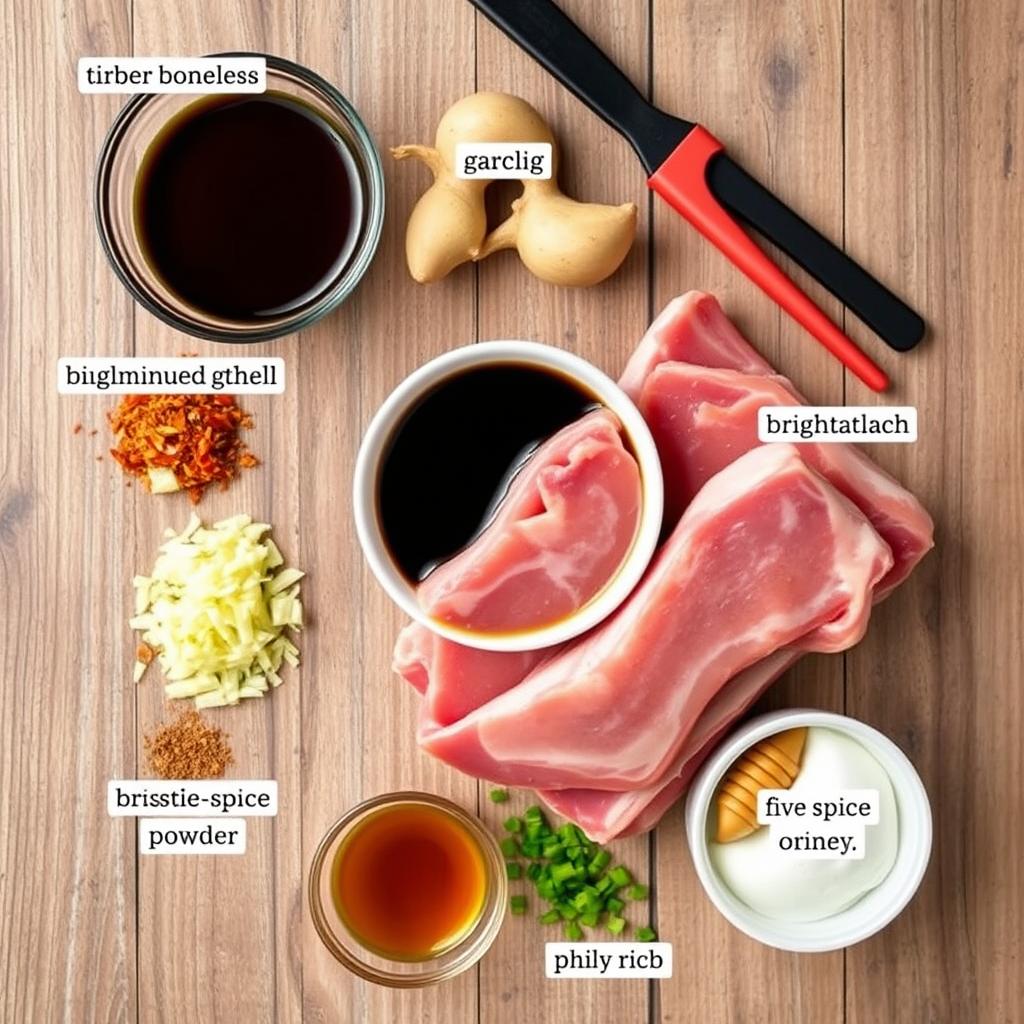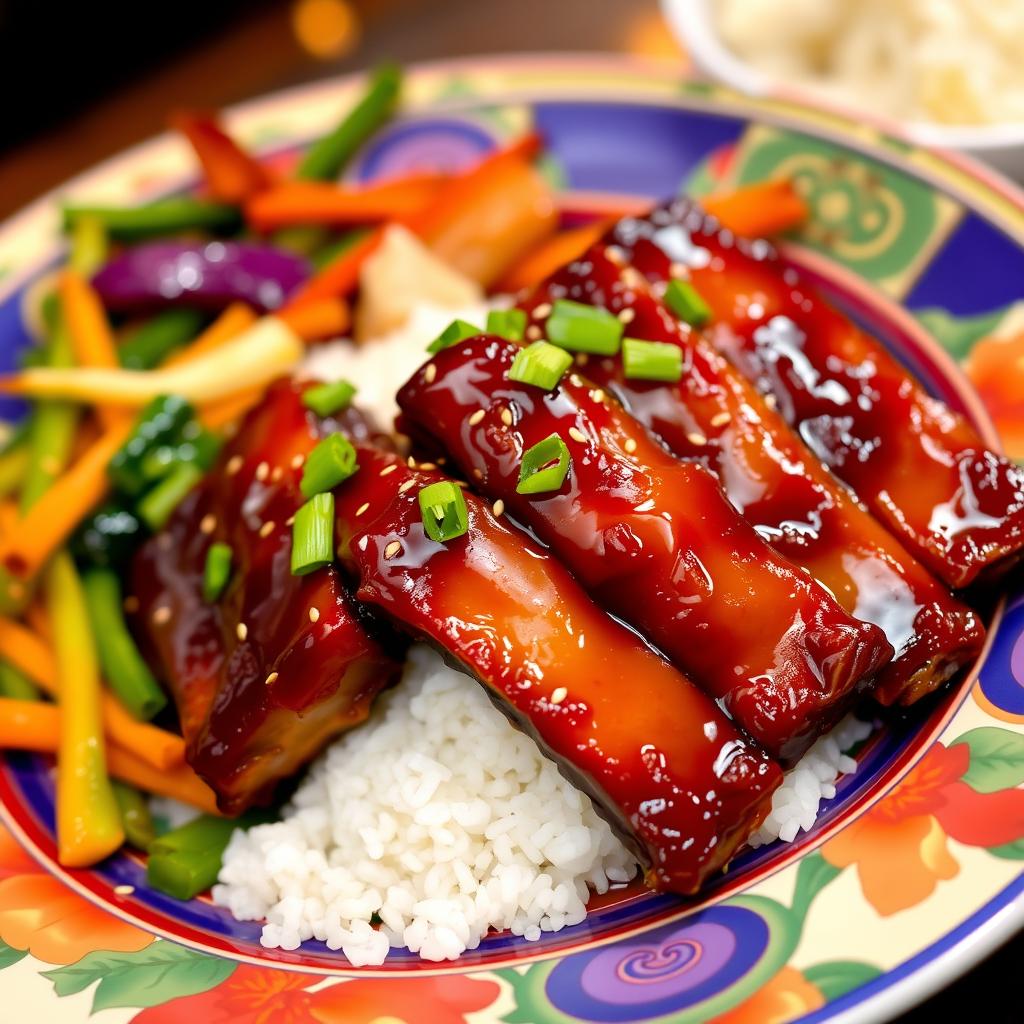Explore the world of boneless spare ribs chinese, a favorite among food lovers in the United States. These ribs are more than a meal; they’re a feast for your taste buds. They mix rich flavors, tender meat, and a glossy glaze that’s hard to resist.
Chinese-style ribs have changed the game in barbecue. They offer a special twist that makes them stand out from traditional American ribs. Every bite is a mix of sweet, savory, and umami flavors that will make your meal unforgettable.
These boneless spare ribs are loved in both home kitchens and fancy restaurants. They show off the amazing flavors and techniques of Chinese cooking. Whether you’re an experienced cook or just starting out, this guide will help you make delicious ribs at home.
Key Takeaways
- Discover the unique flavor profile of Chinese BBQ ribs
- Learn the cultural significance of boneless spare ribs
- Understand the basics of preparing authentic chinese-style ribs
- Explore the versatility of this beloved dish
- Uncover the secrets to achieving perfect texture and taste
Understanding Chinese Boneless Spare Ribs: A Beloved Asian Delicacy
Chinese boneless pork ribs have a long history in food culture. They are loved around the world for their taste and cultural background.

Origins of Chinese BBQ Ribs
The story of chinese rib recipe starts in Southern China, especially in Guangdong province. Street vendors and home cooks turned simple meat into amazing dishes. Traditional cooking methods like marinating and slow-roasting made the meat tender and full of flavor.
“Food is our common ground, a universal experience.” – James Beard
Traditional vs Modern Preparation Methods
Cooking techniques for boneless pork ribs have changed a lot:
- Traditional Method: Charcoal pit roasting with handmade marinades
- Modern Technique: Oven-baked with precise temperatures
- Contemporary Approach: Sous-vide cooking for ultimate tenderness
Cultural Significance in Chinese Cuisine
Asian ribs are more than food – they connect families and celebrate. At festivals and family gatherings, these ribs mean prosperity and joy together.
The rich flavor in a classic chinese rib recipe shows generations of cooking wisdom. It turns simple ingredients into a special dining experience.
Essential Ingredients for Perfect Boneless Spare Ribs Chinese

Starting with the right ingredients is key to making char siu ribs. You need a mix of traditional seasonings and top-notch parts. This mix brings out the deep, complex flavors of Chinese barbecue ribs.
Here are the main ingredients for amazing Chinese spare ribs:
- Pork Meat: Pick boneless pork belly or pork shoulder for the best tenderness
- Soy sauce (dark and light)
- Hoisin sauce for a sweet, deep flavor
- Chinese five-spice powder
- Shaoxing wine or dry sherry
“The secret to remarkable char siu ribs is balancing sweet, savory, and umami flavors.” – Traditional Chinese Cooking Wisdom
Your marinade turns regular pork into a dish to remember. The right mix of ingredients makes your Chinese pork riblets have that glossy, caramelized look.
| Ingredient | Purpose | Flavor Profile |
|---|---|---|
| Maltose | Glazing | Extra sweetness and shine |
| Red Bean Curd | Color Enhancement | Unique umami flavor |
| Garlic | Aromatic Base | Depth and pungency |
Quality is important. Fresh, real ingredients make your Chinese barbecue ribs unforgettable.
Selecting the Right Cut of Meat for Chinese-Style Ribs
Choosing the perfect cut of meat is key for boneless Chinese spare ribs. The right choice can turn a good dish into an amazing one.
Pork Loin vs Pork Shoulder: A Detailed Comparison
When picking meat for Chinese boneless spare ribs, you have two main options: pork loin and pork shoulder. Each has its own special qualities for your dish.
- Pork Loin: Leaner and tender, great for a lighter taste
- Pork Shoulder: Fattier, offering more flavor and juiciness
Quality Indicators for Boneless Pork Ribs
When picking boneless pork ribs, look for these important signs:
| Quality Indicator | What to Look For |
|---|---|
| Meat Color | Fresh, bright pink with minimal discoloration |
| Fat Marbling | Consistent white streaks throughout the meat |
| Texture | Firm to the touch, not soft or mushy |
Butcher’s Expert Tips
Professional butchers suggest these tips for choosing your cut:
- Ask for freshly cut meat
- Choose cuts with consistent marbling
- Think about the cooking method you’ll use
Professional chefs say the secret to amazing Chinese-style ribs is picking the right meat.
For a perfect side dish with your ribs, try these pork tenderloin side dishes to make your meal even better.
The Secret Behind That Signature Red Color
Chinese BBQ ribs stand out with their bright red color. This vibrant hue is not random. It’s a result of a special cooking method with deep roots in Chinese culture.
To understand why Chinese boneless spare ribs are red, we need to look at traditional coloring methods. The color comes from a mix of ingredients and cooking techniques:
- Red fermented bean curd
- Specialized marinades
- Food-grade red coloring
- Traditional spice blends
The most authentic way uses hong zao, or red fermented bean curd. It gives the ribs their red color and a rich, savory taste.
“Color in Chinese cuisine is never just about appearance—it’s about tradition, symbolism, and taste.” – Chef Ming Tsai
Different parts of China have their own ways to get this iconic red color. Some use natural ingredients, while others use modern food coloring.
| Coloring Method | Origin | Flavor Impact |
|---|---|---|
| Red Fermented Bean Curd | Traditional Chinese | Rich, umami |
| Annatto Seed Extract | Southeast Asian Influence | Mild, slightly peppery |
| Food-Grade Red Coloring | Modern Technique | Neutral |
Whether you love cooking or just enjoy eating Chinese BBQ ribs, knowing about the red color makes the dish even more special.
Mastering the Char Siu Marinade
To make authentic char siu ribs, you need to master the marinade. This marinade turns regular pork into a delicious Chinese dish. It’s full of complex flavors that excite your taste buds.
Essential Sauce Components
Your Chinese rib recipe needs a mix of ingredients for depth and richness. A classic char siu marinade includes:
- Hoisin sauce for sweetness
- Soy sauce for umami flavor
- Chinese five-spice powder
- Shaoxing wine or rice wine
- Maltose or honey for glazing
Marination Techniques and Timing
Marinating is key for intense flavors in your char siu ribs. Chefs say to marinate for at least 4-6 hours. But, marinating overnight can make the flavors even better.
| Marination Duration | Flavor Intensity | Recommended Use |
|---|---|---|
| 2-4 hours | Light | Quick preparation |
| 4-8 hours | Medium | Standard method |
| 8-24 hours | Deep | Professional technique |
Flavor Balance Tips
To get the perfect flavor in your Chinese rib recipe, measure carefully and taste often. Start with a little five-spice powder and adjust to taste.
“The secret to amazing char siu ribs is patience and precision in marinading.” – Chinese Culinary Expert
Each ingredient is important for the unique sweet, savory, and tangy taste of char siu ribs. This makes them irresistible.
Step-by-Step Cooking Process for Restaurant-Quality Results
Making authentic boneless spare ribs chinese needs care and love. Your cooking journey begins with careful prep and focus. The right steps can turn simple meat into a memorable chinese-style ribs dish.
- Start by trimming off extra fat from the boneless spare ribs
- Make a strong marinade with key chinese-style ribs ingredients
- Let the meat marinate for 4-6 hours
- Heat your oven to 375°F for the best cooking
- Use a roasting pan with a rack for even heat
Professional chefs say certain cooking methods make ribs tender and tasty:
- Baste often to keep the meat moist
- Turn the meat every 15-20 minutes
- Make sure the internal temperature hits 145°F
“The secret to perfect boneless spare ribs is patience and precision” – Master Chef Liu
Knowing when and how to cook is key. It’s what sets good cooks apart from great ones. Learning these cooking tips will make your chinese-style ribs stand out.
| Cooking Stage | Temperature | Duration |
|---|---|---|
| Initial Roasting | 375°F | 30 minutes |
| Finishing Glaze | 400°F | 10-15 minutes |
With practice, you’ll get the hang of making top-notch boneless spare ribs chinese. They’ll wow your family and friends.
Advanced Cooking Techniques for Chinese Barbecue Ribs
To make your chinese barbecue ribs truly special, you need to learn advanced cooking skills. Professional chefs say that with the right precision and skill, even simple ribs can become a work of art.
Cooking chinese barbecue ribs is more than just basic cooking. You must learn the detailed methods that make restaurant food taste better at home.
Precision Temperature Control
When cooking asian ribs, controlling the temperature is key. You want the meat to be tender and the outside to be just right:
- Use a digital meat thermometer for accuracy
- Keep the oven or grill at a steady temperature
- Shoot for 225-250°F for slow cooking
Strategic Basting Techniques
Basting is what makes chinese barbecue ribs juicy and flavorful. Here are some pro tips:
- Baste every 15-20 minutes
- Use a silicone brush for even coverage
- Apply thin layers of marinade
Achieving the Perfect Glaze
The glaze is what gives great asian ribs their shine. Here are some expert suggestions:
| Glaze Component | Purpose | Recommended Quantity |
|---|---|---|
| Honey | Sweetness and shine | 2 tablespoons |
| Soy Sauce | Umami flavor | 1 tablespoon |
| Five-Spice Powder | Authentic Chinese flavor | 1 teaspoon |
“Mastering the glaze is an art form that separates good ribs from exceptional ones.” – Chef Ming Chen
By practicing these techniques, you can make chinese barbecue ribs that are as good as those in restaurants. The secret is patience, precision, and a love for cooking.
Side Dishes and Pairing Suggestions
Choosing the right side dishes can make your meal better. The rich flavor of chinese spare ribs needs dishes that balance and enhance it.
Here are some classic side dishes that go well with chinese pork riblets:
- Steamed white rice
- Garlic bok choy
- Vegetable spring rolls
- Egg drop soup
- Cucumber salad
For a well-rounded meal, try these drinks:
| Beverage Type | Recommended Options |
|---|---|
| Alcoholic | Tsingtao Beer, Sake, Riesling |
| Non-Alcoholic | Green Tea, Jasmine Tea, Lychee Juice |
“The right side dish can transform a good meal into an unforgettable culinary experience.” – Chef Ming Tsai
When picking side dishes, look for a mix of textures and flavors. Choose light, crisp veggies and cool drinks to balance the meat’s richness.
Storage Tips and Reheating Methods
Keeping your chinese-style ribs tasty means storing and reheating them right. Follow these tips to keep your boneless spare ribs chinese as tasty as the first time.
Refrigeration Strategies
Here’s how to keep your ribs in top shape:
- Cool the ribs completely before storing
- Use airtight containers to prevent moisture loss
- Refrigerate within two hours of cooking
- Store for maximum 3-4 days in the refrigerator
Freezing Techniques
Freezing is a great way to keep your ribs fresh longer. Wrap each portion in plastic wrap, then in a freezer-safe bag. They’ll last up to 3 months.
Reheating Without Losing Flavor
Here’s how to reheat your ribs without losing flavor:
- Oven Method: Preheat to 250°F, cover ribs with foil, heat for 15-20 minutes
- Air Fryer: Reheat at 350°F for 5-7 minutes, turning once
- Add a small splash of water or broth to prevent drying
“The secret to great reheated ribs is low and slow heating” – Professional Chef
Always check the ribs’ internal temperature reaches 165°F for safety when reheating.
Common Cooking Mistakes to Avoid
Making perfect boneless pork ribs can be hard. Even skilled cooks can mess up, ruining a tasty dish. Knowing these common errors helps you make top-notch boneless pork ribs every time.
Top Cooking Errors to Watch Out For
- Overlooking Meat Selection: The wrong cut can ruin your dish before cooking starts
- Improper Marination: Quick marinating means less flavor
- Temperature Mismanagement: Wrong cooking temperatures cause uneven results
Many home cooks forget about meat prep. Your boneless pork ribs need careful trimming and marinating for that real Chinese BBQ taste.
| Mistake | Consequence | Solution |
|---|---|---|
| Overcooking | Dry, tough meat | Use meat thermometer, cook to 145°F |
| Under-seasoning | Bland flavor profile | Marinate for minimum 2-4 hours |
| Wrong Heat Level | Burnt exterior, raw interior | Use moderate, consistent heat |
“Patience and precision are the secret ingredients in any great chinese rib recipe.” – Professional Chef
By knowing these common mistakes, you’ll make your boneless pork ribs amazing. Remember, cooking is all about learning and getting better.
Conclusion
Making delicious Chinese boneless spare ribs at home is easier than you think. Many wonder if boneless ribs are real ribs. But, these tasty cuts offer a real taste experience that’s as good as restaurant food. By using the techniques and ingredients we’ve talked about, you can make dishes that taste like they came from a restaurant.
People who care about nutrition often ask if Chinese boneless spare ribs are healthy. When made with care, this dish can be a good part of a healthy diet. Choosing lean pork, controlling marinade ingredients, and watching portion sizes can make these ribs a protein-packed meal. If you’re looking for a healthy Chinese meal, try making traditional recipes with lighter cooking methods.
Trying different marinades, cooking methods, and flavors will help you get better at making this classic Chinese dish. Remember, cooking is an art. Every try gets you closer to making it perfect. Your homemade boneless spare ribs can become a hit with family and friends, mixing traditional cooking with your own twist.
Starting your cooking journey is exciting. Enjoy learning and making new dishes. Your love for cooking and trying new flavors will help you succeed in making these tasty Chinese spare ribs.
FAQ
What cut of meat are Chinese boneless spare ribs typically made from?
Chinese boneless spare ribs come from pork shoulder, also known as pork butt. This cut has the right mix of meat and fat. It makes the ribs tender and juicy, with a rich flavor.
Why are Chinese boneless spare ribs red in color?
The red color comes from the marinade, which includes red fermented bean curd or food coloring. Recipes use five-spice powder and char siu sauce. These ingredients give the ribs their distinctive reddish-brown glaze.
Are Chinese boneless spare ribs healthy?
Chinese boneless spare ribs are tasty but high in calories and fat. Enjoy them in moderation as part of a balanced diet. To make them healthier, choose leaner cuts and use less sugar in the marinade. Pair them with lots of vegetables.
What do Chinese spare ribs taste like?
Chinese spare ribs have a mix of sweet, savory, and umami flavors. The marinade combines honey or maltose, soy sauce, five-spice powder, and garlic. This creates a rich, slightly sweet taste that’s intense yet nuanced.
How are Chinese boneless spare ribs different from traditional American BBQ ribs?
Chinese spare ribs are less smoky and sweeter, with a soy-based marinade. They’re cooked using char siu methods, which include marinading, roasting, and glazing. This results in a shinier, caramelized exterior, unlike American-style ribs.
Can I make Chinese boneless spare ribs at home?
Yes, you can make authentic Chinese boneless spare ribs at home. Use a good marinade, choose the right meat, and slow roast with frequent basting. This will give you that signature glazed finish.
What are the best side dishes to serve with Chinese boneless spare ribs?
Serve them with steamed white rice, stir-fried vegetables, egg rolls, and cucumber salad. For a balanced meal, add bok choy, steamed dumplings, or a light Asian-style slaw. These complement the ribs’ rich flavors.
How long can I store leftover Chinese boneless spare ribs?
Store them in an airtight container in the fridge for 3-4 days. For the best taste, reheat in the oven or air fryer. This keeps the crispy exterior and prevents sogginess.

